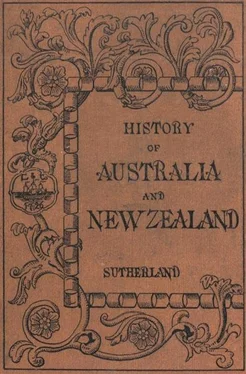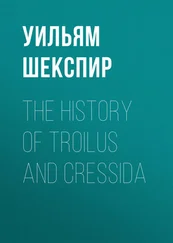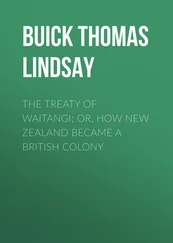Burke and King walked out on their desperate errand. On the first day they traversed a fair distance; but, on the second, they had not proceeded two miles when Burke lay down, saying he could go no farther. King entreated him to make another effort, and so he dragged himself to a little clump of bushes, where he stretched his limbs very wearily. An hour or two afterwards he was stiff and unable to move. He asked King to take his watch and pocket-book, and, if possible, to give them to his friends in Melbourne; then he begged of him not to depart till he was quite dead: he knew he should not live long, and he should like some one to be near him to the last. He spoke with difficulty, but directed King not to bury him, but to let him lie above the ground, with a pistol in his right hand. They passed a weary and lonesome night; and in the morning, at eight o’clock, Burke’s restless life was ended. King wandered for some time forlorn, but, by good fortune, he stumbled upon an abandoned encampment, where, by neglect, the blacks had left a bag of nardoo, sufficient to last him a fortnight; and, with this, he hastened back to the hut where Wills had been laid. All he could do now, however, was to dig a grave for his body in the sand, and, having performed that last sad duty, he set out once more on his search, and found a tribe, differing from that which he had already seen. They were very kind, but not anxious to keep him, until, having shot some birds and cured their chief of a malady, he was found to be of some use, and soon became a great favourite with them. They made a trip to the body of Burke, but, respecting his last wishes, they did not seek to bury it, and merely covered it gently with a layer of leafy boughs.
5. Relief Parties.—When Wright and Brahe returned to Victoria with the news that, though it was more than five months since Burke and Wills had left Cooper’s Creek, there were no signs of them at the depôt, all the colonies showed their solicitude by organising parties to go to the relief of the explorers, if, perchance, they should be still alive. Victoria was the first in the field, and the Royal Society equipped a small party, under Mr. A. W. Howitt, to examine the banks of Cooper’s Creek. Queensland offered five hundred pounds to assist in the search, and with this sum, an expedition was sent to examine the Gulf of Carpentaria. Landsborough, its leader, was conveyed in the Victoria steamer to the gulf, and followed the Albert almost to its source, in hopes that Burke and Wills might be dwelling with the natives on that stream. Walker was sent to cross from Rockhampton to the Gulf of Carpentaria; he succeeded in reaching the Flinders River, where Burke and Wills had been; but, of course, he saw nothing of them. MʻKinlay was sent by South Australia to advance in the direction of Lake Torrens and reach Cooper’s Creek. These various expeditions were all eager in prosecuting the search, but it was to Mr. Howitt’s party that success fell. In following the course of Cooper’s Creek downward from the depôt he saw the tracks of camels, and by these he was led to the district in which Burke and Wills had died.
Several natives, whom he met, brought him to the place where, beneath a native hut, King was sitting, pale, haggard, and wasted to a shadow. He was so weak that it was with difficulty Howitt could catch the feeble whispers that fell from his lips; but a day or two of European food served slightly to restore his strength. Howitt then proceeded to the spot where the body of Wills was lying partly buried, and, after reading over it a short service, he interred it decently. Then he sought the thicket where the bones of Burke lay with the rusted pistol beside them, and, having wrapped a union jack around them, he dug a grave for them hard by.
Three days later the blacks were summoned, and their eyes brightened at the sight of knives, tomahawks, necklaces, looking-glasses, and so forth, which were bestowed upon them in return for their kindness to King. Gay pieces of ribbon were fastened round the black heads of the children, and the whole tribe moved away rejoicing in the possession of fifty pounds of sugar, which had been divided among them.
When Howitt and King returned, and the sad story of the expedition was related, the Victorian Government sent a party to bring the remains of Burke and Wills to Melbourne, where they received the melancholy honours of a public funeral amid the general mourning of the whole colony. In after years, a statue was raised to perpetuate their heroism and testify to the esteem with which the nation regarded their memory.
6. MʻDouall Stuart.—Burke and Wills were the first who ever crossed the Australian Continent; but, for several years before they set out, another traveller had, with wonderful perseverance, repeatedly attempted this feat. John MʻDouall Stuart had served as draughtsman in Sturt’s expedition to the Stony Desert, and he had been well trained in that school of adversity and sufferings. He was employed, in 1859, by a number of squatters, who wished him to explore for them new lands in South Australia, and having found a passage between Lake Eyre and Lake Torrens, he discovered, beyond the deserts which had so much disheartened Eyre, a broad district of fine pastoral land.
Next year the South Australian Government offered £2,000 as a reward to the first person who should succeed in crossing Australia from south to north; and Stuart set out from Adelaide to attempt the exploit. With only two men he travelled to the north, towards Van Diemen’s Gulf, and penetrated much farther than Sturt had done in 1844. Indeed, he was only 400 miles from the other side of Australia, when the hostility of the blacks forced him to return: he succeeded, however, in planting a flag in the centre of the continent, at a place called by him Central Mount Stuart. Next year he was again in the field, and following exactly the same course, approached very near to Van Diemen’s Gulf; being no more than 250 miles distant from its shores, when want of provisions forced him once more to return. The report of this expedition was sent to Burke and Wills, just before they set out from Cooper’s Creek on their fatal trip to the Gulf of Carpentaria.
It was not until the following year, 1862, that Stuart succeeded in his purpose. He had the perseverance to start a third time, and follow his former route; and on this occasion he was successful in reaching Van Diemen’s Gulf, and returned safely, after having endured many sufferings and hardships.
His triumphal entry into Adelaide took place on the very day when Howitt’s mournful party entered that city, bearing the remains of Burke and Wills, on their way to Melbourne. Stuart then learnt that these brave explorers had anticipated him in crossing the continent, for they had reached the Gulf of Carpentaria in February, 1861; whilst he did not arrive at Van Diemen’s Gulf until July, 1862. However, Stuart had shown so great a courage, and had been twice before so near the completion of his task, that every one was pleased when the South Australian Government gave him the well-merited reward.
7. Warburton.—In a subsequent chapter it will be told how a line of telegraph was, in 1872, constructed along the track followed by Stuart; and as the stations connected with this line are numerous, it is now an easy matter to cross the continent from south to north. But in recent years a desire has arisen among the adventurous to journey overland from east to west. Warburton, in 1873, made a successful trip of this kind. With his son, two men, and two Afghans to act as drivers of his seventeen camels, he started from Alice Springs, a station on the telegraph line close to the tropic of Capricorn.
The country immediately round Alice Springs was very beautiful, but a journey of only a few days served to bring the expedition into a dry and barren plain, so desolate that Warburton declared it could never be traversed without the assistance of camels. After travelling about four hundred miles, he reached those formidable ridges of fiery red sand in which the waters of Sturt’s Creek are lost, and where A. C. Gregory was in 1856 compelled to turn back. In traversing this district, the party suffered many hardships; only two out of seventeen camels survived, and the men were themselves frequently on the verge of destruction. It was only by exercising the greatest care and prudence that Warburton succeeded in bringing his party to the Oakover River, on the north-west coast, and when he arrived once more in Adelaide it was found that he had completely lost the sight of one eye.
Читать дальше












